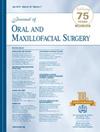Evaluation of Lingual Fracture Pattern Following Sagittal Split With the Low and Short Medial Osteotomy
IF 2.3
3区 医学
Q2 DENTISTRY, ORAL SURGERY & MEDICINE
引用次数: 0
Abstract
Background
The lingual split scale (LSS) following sagittal ramus osteotomy (SRO) is an objective scale where LSS1 to 3 are variations of a favorable split, while LSS4 is an unfavorable split. LSS influences postoperative bone overlap, posterior interferences, and fixation methods. There is currently no study evaluating LSS following SRO using the low and short medial osteotomy modification.
Purpose
The purpose of this study is to describe the lingual fracture pattern of the distal segment through the LSS following SRO using the low and short medial osteotomy modification.
Study Design, Setting, and Sample
A retrospective cohort study of subjects undergoing SRO with the low and short medial osteotomy by a single surgeon at The University of Alabama at Birmingham between February 2020 and July 2024. Subjects with incomplete records were excluded.
Predictor Variables
Anatomic predictor variables were ramus width and length and the vertical height of the lingula. Procedural predictor variables were height and angle of the medial osteotomy, medial osteotomy relative to the lingula and to the mandibular canal, and third molar removal at the time of SRO.
Main Outcome Variable
The primary outcome variable was the LSS. LSS1 to 3 are variations of a favorable SRO split, while LSS4 is unfavorable.
Covariates
Covariates include age, sex, and previous mandibular osteotomies.
Analyses
The significance level was defined as P < .05. Multivariate regression analyses assessed variables that were near statistically significant (P < .2). Hemimandibles were correlated and the subject factor was accounted for using generalized estimating equations.
Results
The study sample had 210 subjects (419 hemimandibles). LSS variations of favorable splits resulted in 263 (62.8%) vertical fractures (LSS1), 8 (1.9%) horizontal fractures (LSS2), and 139 (33.2%) fractures along the mandibular canal (LSS3). Nine (2.2%) unfavorable splits (LSS4) were present. No variables were found to be significantly associated with unfavorable fractures (LSS4).
Conclusions and Relevance
SRO using the low and short medial osteotomy resulted in predictable LSS patterns. Favorable fracture patterns (LSS1 to 3) were present in 97.8% (410) of SROs, while unfavorable fracture patterns (LSS4) were present in 2.2% (9). No variables were identified to be significantly associated with unfavorable fracture (LSS4).
矢状面切开“低短”内侧截骨术后舌骨骨折类型的评价。
背景:矢状支截骨术(SRO)后的舌裂量表(LSS)是一个客观的量表,其中LSS1至3为有利分裂的变化,而LSS4为不利分裂。LSS影响术后骨重叠、后路干扰和固定方法。目前还没有研究评估SRO后使用低短内侧截骨术的LSS。目的:本研究的目的是描述在SRO后使用低短内侧截骨改良术通过LSS的远端舌骨骨折模式。研究设计、环境和样本:2020年2月至2024年7月期间,阿拉巴马大学伯明翰分校一名外科医生对接受SRO手术的患者进行了低位和短段内侧截骨术的回顾性队列研究。排除记录不完整的受试者。预测变量:解剖学预测变量为支的宽度、长度和舌的垂直高度。程序预测变量为内侧截骨高度和角度,内侧截骨相对于舌骨和下颌管,以及在SRO时移除第三磨牙。主要结局变量:主要结局变量为LSS。LSS1到3是有利的SRO分裂的变体,而LSS4则是不利的。协变量:协变量包括年龄、性别和以前的下颌截骨手术。分析:显著性水平定义为P。结果:研究样本有210名受试者(残疾419名)。LSS有利分裂的变化导致263例(62.8%)垂直骨折(LSS1), 8例(1.9%)水平骨折(LSS2)和139例(33.2%)沿下颌管骨折(LSS3)。出现9例(2.2%)不良裂(LSS4)。没有发现与不利骨折(LSS4)显著相关的变量。结论和相关性:采用低位和短内侧截骨术的SRO可导致可预测的LSS模式。97.8%(410例)的sro存在有利骨折模式(LSS1 - 3),而2.2%(9例)的sro存在不利骨折模式(LSS4)。没有发现与不利骨折模式(LSS4)显著相关的变量。
本文章由计算机程序翻译,如有差异,请以英文原文为准。
求助全文
约1分钟内获得全文
求助全文
来源期刊

Journal of Oral and Maxillofacial Surgery
医学-牙科与口腔外科
CiteScore
4.00
自引率
5.30%
发文量
0
审稿时长
41 days
期刊介绍:
This monthly journal offers comprehensive coverage of new techniques, important developments and innovative ideas in oral and maxillofacial surgery. Practice-applicable articles help develop the methods used to handle dentoalveolar surgery, facial injuries and deformities, TMJ disorders, oral cancer, jaw reconstruction, anesthesia and analgesia. The journal also includes specifics on new instruments and diagnostic equipment and modern therapeutic drugs and devices. Journal of Oral and Maxillofacial Surgery is recommended for first or priority subscription by the Dental Section of the Medical Library Association.
 求助内容:
求助内容: 应助结果提醒方式:
应助结果提醒方式:


